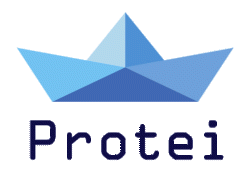
The Protei project is a robotics project initiated by Scoutbots, a Hong Kong-based non-profit organization founded by Cesar Harada.
Initially the project was started to help clean up the BP Oil Spill in the Gulf of Mexico in 2010. Workers, who cleaned up the BP Oil Spill, were exposed to toxic chemicals and were only able to clean up a small amount of spilled oil.
The BP Oil Spill, also referred to as "The Deepwater Horizon oil spill, began in April 2010 on board the Macondo Prospect, which was operated by BP. Claiming eleven lives, it is still considered the largest accidental marine oil spill in the history of the petroleum industry.
The Protei project aims at developing a way of cleaning the oceans using autonomous sailing robots ("Protei") that are able to work together using swarm technology.
 Protei Schematic - Picture: Cesar Harada
Protei Schematic - Picture: Cesar Harada
Spilled oil moves downwind from its source due to wind and surface currents. Traditional oil skimmers proved to be inefficient since they cut random linear paths through these oil spills cleaning up only 3%.
The way Protei works is different. It first sails upwind, past the spill. As it is sailing downwind again, it intercepts the oil sheens making the Protei more effective than these traditional cleanup vehicles.
Protei features a number of innovative design tweaks that make it a cost-effective way to control pollution and conduct research, including the ability to expand and carry multiple sets of research and cleanup equipment at the same time.
The biggest innovation of the Protei is the shape-shifting hull, which allows the robot to control a long and heavy payload since no rudder is needed: the Protei features a level of trajectory control never before seen in sailing.
Hypothetical advantages of a shape-shifting hull
 Protei with Shape-Shifting Hull - Picture: Cesar Harada
Protei with Shape-Shifting Hull - Picture: Cesar Harada
In 2011 Protei started a Kickstarter campaign to fund further development and successfully ended the campaign with a raised total of $33,795.
On April 8, 2014, an update to the project announced that 10 new prototypes were constructed from late 2013 to early 2014. These prototypes bring the project closer to establishing the following as features in the finished product:
Since the ultimate goal of Scoutbots is to develop fleets of Protei that can work together using swarm technology, the team has listed the following steps that are necessary to complete that vision come to life:
Remote controlled: we have successfully been sailing remote controlled Protei from 0.5 to 3m in length. We have built about 10 functional prototypes that demonstrate these new properties.
Autonomous: Each Protei would sense its environment, make decisions and sustain it's own energy production.
Centralized swarm: Many units controlled by one computer on land.
Decentralized Swarm: Each unit has a computer on board and makes its own decision aware of the complex situation.
Overridable online swarm: The swarm of Sailing robots operates autonomously but can be overridden by on-line gamers, smart phones, tablets or computer users that can control single units or sub-groups of Protei robots.
At this moment the Protei team works hard to add new features to Protei. Protei will be expandable to carry multiple experiments at the same time. This will make Protei the ideal platform for oceanic research.
Protei will be equipped with Radio Control using Arduino software, able to connect to an Android phone or to an iridium phone for global coverage.
Swarm technology will be used to have multiple Protei robots work together as a team. By communicating and coordinating with each other the research or cleaning up will be much more efficient.
 Protei Cleaning Pollution - Picture: Cesar Harada
Protei Cleaning Pollution - Picture: Cesar Harada
The name "Protei" comes from the plural for "Proteus", the Greek sea-god and son of Poseidon. Proteus was known for his mutability, his capability of assuming many forms or shapes. The word "protean" evokes flexibility, versatility and adaptability.
Scoutbots is a Hong Kong-based non-profit organization dedicated to develop Open Hardware technologies to explore and protect the Ocean. For the moment Scoutbots is focused primarily on Protei, but they plan to eventually develop more technologies for exploring and protecting the ocean.